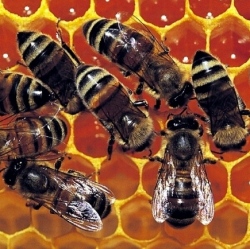
Researchers have developed a robot that perceives environmental stimuli and learns to react to them. The scientists used the relatively simple nervous system of the honeybee as a model for its working principles. To this end, they installed a camera on a small robotic vehicle and connected it to a computer.
The computer program replicated in a simplified way the sensorimotor network of the insect brain. The input data came from the camera that, akin to an eye, received and projected visual information. The neural network, in turn, operated the motors of the robot wheels, and could thus control its motion direction.
The outstanding feature of this artifical mini brain is its ability to learn by simple principles. "The network-controlled robot is able to link certain external stimuli with behavioral rules," says Professor Martin Paul Nawrot, head of the research team and professor of neuroscience at Freie Universität Berlin. "Much like honeybees learn to associate certain flower colors with tasty nectar, the robot learns to approach certain colored objects and to avoid others."
In the learning experiment, the scientists located the network-controlled robot in the center of a small arena. Red and blue objects were installed on the walls. Once the robot’s camera focused on an object with the desired color-red, for instance-, the scientists triggered a light flash. This signal activated a so-called reward sensor nerve cell in the artificial network.
The simultaneous processing of red color and the reward now led to specific changes in those parts of the network, which exercised control over the robot wheels. As a consequence, when the robot "saw" another red object, it started to move toward it. Blue items, in contrast, made it move backwards. "Just within seconds, the robot accomplishes the task to find an object in the desired color and to approach it," explains Nawrot. "Only a single learning trial is needed, similar to experimental observations in honeybees."
